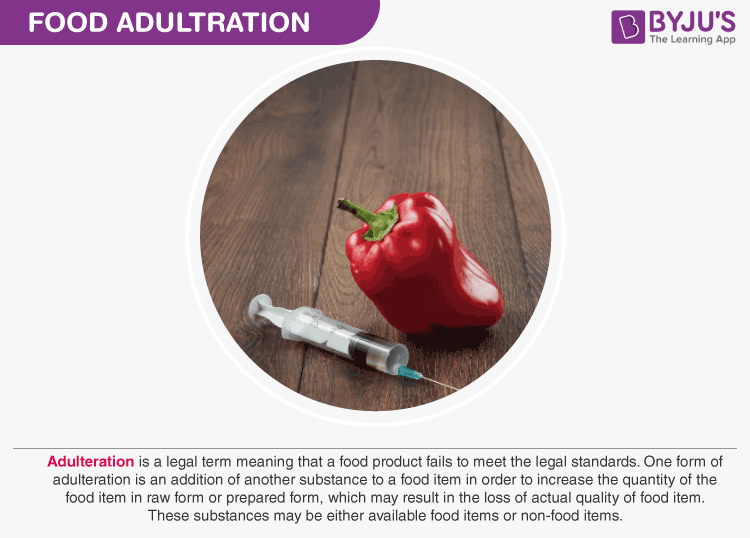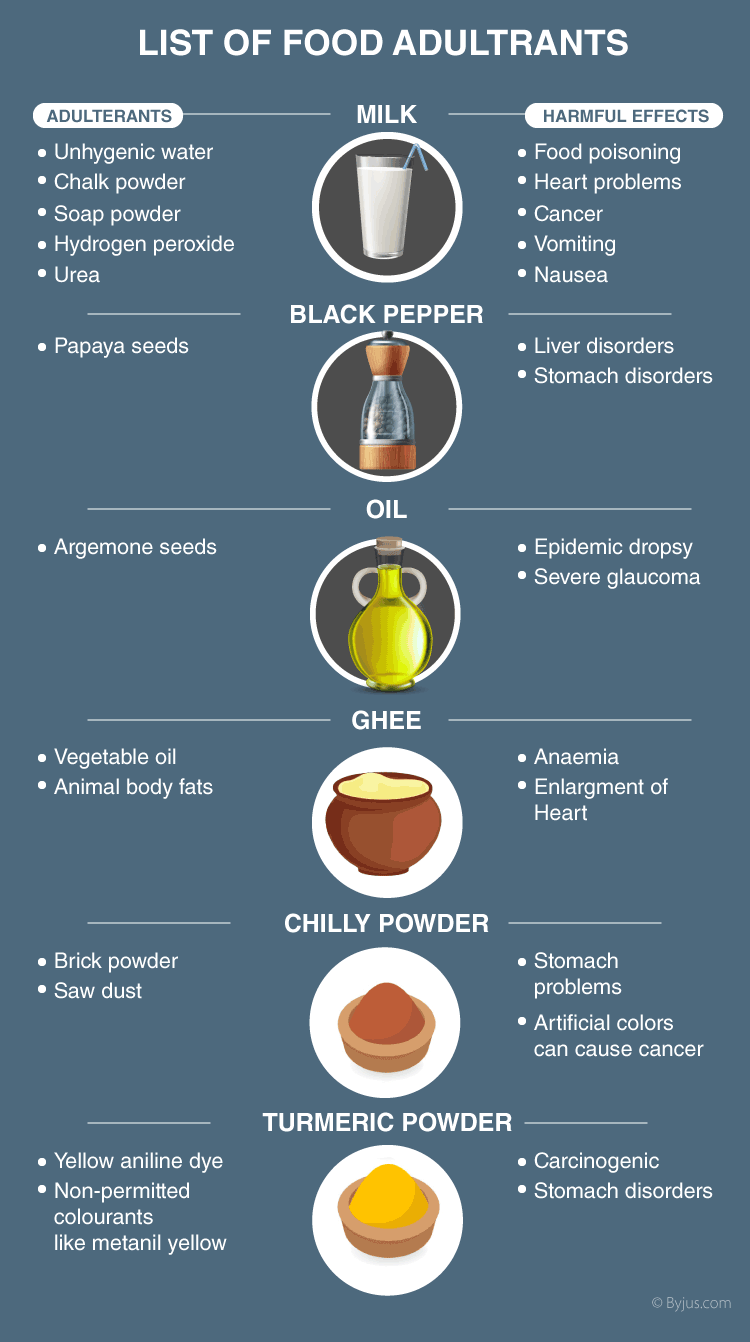What Are the Types of Food Adulteration
Food is essential for sustenance of life. We all eat food and gain energy for different metabolic activities. All living organisms need food for growth, work, repair and maintaining life processes.
There are different types of food available today in the market, and on a daily basis, we all depend on various food sources, including vegetables, fruits, cereals, pulses, legumes, etc.
As we buy fresh veggies and other groceries, we might have come across small pebbles in cereals and grains, darkly stained vegetables like cabbage, broccoli, fruits, dark red meat and a lot more.
Table of Contents
What Is Food Adulteration?
Why Food Adulteration is done?
Methods of Food Adulteration
How can Adulteration be Prevented?
Adulteration or contamination of natural food products is one of the major challenges in today's society. Despite various actions and penalties, the practice of adding adulterant is quite common in developing countries. There are various methods used for adulterating natural products.
Here, in this topic, let us learn what exactly adulteration is? What are the different types of adulterants added to the grains, veggies and other food products?
What Is Food Adulteration?

Food Adulteration can be defined as the practice of adulterating food or contamination of food materials by adding a few substances, which are collectively called adulterants.
Adulterants are the substance or poor quality products added to food items for economic and technical benefits. Addition of these adulterants reduces the value of nutrients in food and also contaminates the food, which is not fit for consumption. These adulterants can be available in all food products which we consume daily, including dairy products, cereals, pulses, grains, meat, vegetables, fruits, oils, beverages, etc.
Food: Where Does It Come From?
Why is Food Adulteration done?
The process of contaminating food or adding to the food components is a common phenomenon in developing countries.
For instance: Milk can be diluted by adding water to increase its quantity and starch powder is often added to increase its solid content.
Listed below are the main reasons for adulterating food products:
- Practised as a part of the business strategy.
- An imitation of some other food substance.
- Lack of knowledge of proper food consumption.
- To increase the quantity of food production and sales.
- Increased food demand for a rapidly growing population.
- To make maximum profit from food items by fewer investments.
Explore more about Food Production
Methods of Food Adulteration
Here is a list of most common adulterants which have been added
- Adding certain chemicals for faster ripening of fruits.
- Mixing of decomposed fruits and vegetables with the good ones.
- Adding certain natural and chemical dyes to attract consumers.
- Mixing of clay, pebbles, stones, sand, and marble chips, to the grains, pulses and other crops.
-
Cheaper and inferior substances are added wholly or partially with the good ones to increase the weight or nature of the product.
Adulteration is an illegal practice of adding raw and other cheaper ingredients to excellent quality products to increase the quantity. Having this adulterated food is highly toxic and leads to several health issues, including certain nutrition deficiency diseases, kidney disorders, and failure of an individual's organ systems, including heart, kidney and liver.
Also, refer: Food deficiency
Below is a list of a few adulterants added to the food products along with their harmful effects.

| Food Products | Adulterant | Harmful Effects |
| Milk and Curd | Water and starch powder. | Stomach disorders. |
| Ghee, Cheese and Butter | Mashed potatoes, Vanaspati and starch powder. | Gastro-intestinal disturbances and other stomach disorders. |
| Grains | Dust, Pebbles, Stones, Straw, weed seeds, damaged grain, etc. | Liver disorders, Toxicity in the body, etc. |
| Pulses | Dyes, chemical and Lead Chromate. | Stomach disorders. |
| Coffee powder | Chicory, tamarind seeds powder. | Diarrhoea. |
| Tea | Artificial colouring agents. | Liver disorders. |
| Sugar | Chalk powder, Washing soda, Urea, etc. | Stomach disorders and kidney failure. |
| Pepper | Dried papaya seeds and blackberries. | Severe allergic reactions including stomach and skin irritations. |
| Mustard seeds | Argemone seeds. | Abdominal contractions, sluggishness and increased excretion. |
| Edible Oils | Mineral oil, Karanja oil, castor oil and artificial colours. | Gallbladder cancer, allergies, paralysis, cardiac arrest, and increased LDL cholesterol. |
| Turmeric Powder | Pesticide residues, sawdust, chalk dust, industrial dyes, metanil yellow dye arsenic, lead metal etc. | Cancer and Stomach disorders. |
| Chilli and Coriander powder | Redbrick powder, Rhodamine B dye, Red lead, dung powder, soluble salts, water-soluble synthetic colours and other common salts. | Metal toxicity, Cancer, lead poisoning, tumour, variations in blood pressure and other stomach related disorders. |
| Cinnamon sticks | Cassia bark. | Liver Damage, Low Blood Sugar, Mouth Sores and increased risk of cancer. |
| Cumin seeds | Coloured grass seeds, sawdust and charcoal dust | Stomach disorders. |
| Jam, Juice and Candies | Non-permitted dyes including metanil yellow and other artificial food dyes. | These dyes are highly carcinogenic that have the potential to cause different types of cancer. |
| Jaggery | Washing soda, chalk powder | Vomiting and other Stomach disorders |
| Honey | Molasses, dextrose, sugar and corn syrups | Stomach disorders |
| Fruits and Vegetables | Chemical dyes, Malachite green, calcium carbide, copper sulphate and oxytocin saccharin wax. | Stomach disorders, vomiting, and dyes used are highly carcinogenic. |
| Tomato sauces | Pumpkin pulp, non-edible artificial colours and flavours. | Gastritis and inflammation of vital organs. |
| Ice Cream | Pepper oil, ethyl acetate, butyraldehyde, nitrate, washing powder. The kind of gum is added which is prepared by boiling different animal parts including the tail, udder, nose, etc. | Dreadful diseases that affect organs including lungs, kidneys, and heart. |
How can Adulteration be Prevented?
According to the National Health Service and Food Research Institute, several food products have been adulterated to increase the quantity and make more profit. This practice of adding adulterants to food products are quite common in all in developing countries and other backward countries.
Every year, the 7th of April is celebrated as the World Health Day globally and as per the reports, WHO aims to bring a general awareness about the adulterations of food products, motivate and inspire everybody to have a healthy, balanced diet.
Also refer: Food Poisoning
Here are certain safety tips to avoid Adulteration
- Avoid dark coloured, junk and other processed foods.
- Make sure to clean and store all the grains, pulses and other food products.
- Wash fruits and vegetables thoroughly in running water before they are used.
- Check if the seal is valid or not, before buying food products like milk, oil and other pouches.
- Always make sure to check and buy products having an FSSAI-validated label, along with the license number, list of ingredients, manufactured date, and its expiration.
Explore more about – Food Processing
Stay tuned with BYJU'S to learn more in detail about food adulteration and other related topics at BYJU'S Biology
What Are the Types of Food Adulteration
Source: https://byjus.com/biology/food-adulteration/
0 Response to "What Are the Types of Food Adulteration"
Post a Comment